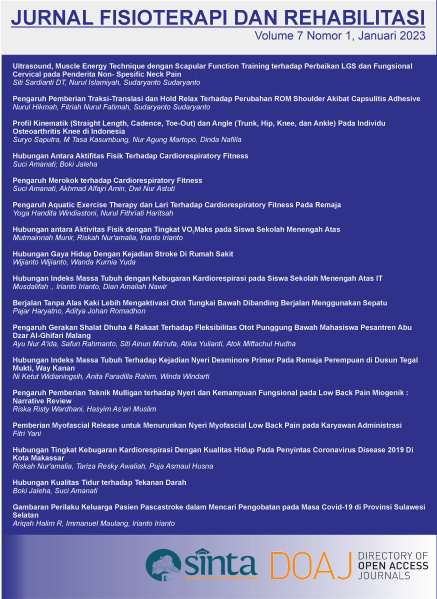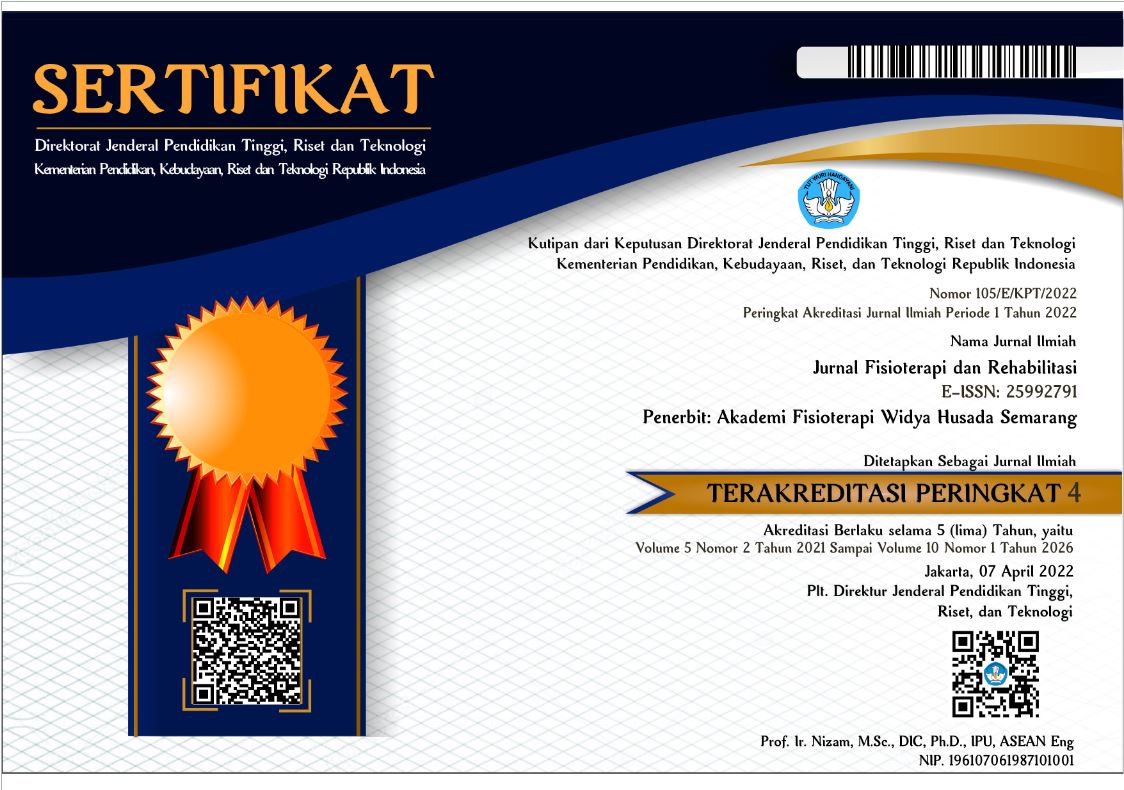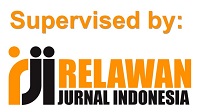Pengaruh Pemberian Traksi-Translasi dan Hold Relax Terhadap Perubahan ROM Shoulder Akibat Capsulitis Adhesive
The Effect Of Traction-Translation and Hold Relax on Changes Due ROM Shoulder Adhesive Capsulitis
Abstract
Latar Belakang : Capsulitis Adhesive adalah gangguan yang terjadi di area bahu berupa peradangan pada kapsul sendi yang menyebabkan rasa kaku dan nyeri. Penelitian ini bertujuan untuk mengetahui pengaruh pemberian trkasi-translasi dan hold relax terhadap perubahan ROM shoulder pada pasien Capslitis adhesive. Metode : Penelitian ini adalah penelitian Pra Eksperimen dengan One group pre-test & post-test design. Populasi sampel adalah penderita Capsulitis Adhesive Poli Fisioterapi Rumah Sakit Umum Daerah Barru. Pengambilan data pasien dengan menggunakan goniometer pre-test dan post-test. Selama masa penelitian jumlah sampel sebanyak 12 responden yang diambil menggunakan teknik total sampling yaitu seluruh penderita. Hasil : Hasil penelitian menunjukkan penderita yang mengalami Capsulitis Adhesive lebih banyak dialami kelompok usia ≥ 45 tahun dan jenis kelamin sebagian besar perempuan. ROM sebelum & sesudah pemberian intervensi menunjukkan ada perubahan yang signifikan dari nilai p=0,000 dengan tingkat kepercayaan 95%. Berdasarkan Uji Paired Sampel T Test dengan nilai p= 0,000 < (0,05) telah memperlihatkan bahwa terdapat pengaruh traksi-translasi dan hold relax terhadap perubahan ROM pada penderita Capsulitis Adhesive. Kesimpulan : Disimpilkan bahwa ROM sebelum & sesudah pemberian traksi-translasi & hold relax memperlihatkan ada perubahan ROM setelah diberikan teknik traksi-translasi dan hold relax.
Downloads
References
American Academy of Orthopedic Surgeon, 2012; Frozen Shoulder; diakses tanggal 15/01/2019.http://www.orthoinfo.aaos.org/topic.cfm?topic=A00071&return_Link=0
Anshar, Sudaryanto, Halima, A., Hendrik. 2017. Buku Panduan Skripsi Prodi D.IV Fisioterapi. Makassar : Politeknik Kesehatan Kemenkes Makassar
Buomans, M.T.A., Ooy, A. 2009. The Examination of the Upper Extremities. First edition. Netherlands : Massticht University.
Bambang Trisnowiyanto. 2016. Beda Pengaruh Intervensi Peregangan Dan Mobilisasi Sendi Terhadap Perbaikan Keterbatasan Lingkup Gerak Sendi. Jurnal Kesehatan. Vol VII No 2
Brotzman, MD, Robert C, Manske, PT. 2012. Clinical Orthopaedic Rehabilitation. Third Edition, Elseiver Churacil Livingstone.
Chen et al, 2009 ; Passive Mobilization of Shoulder Region Joints Plus Advice and Exercise does not Reduce Pain and Disability
Clewley Derek,Flynn Timothy, and Koppenhaver Shane. 2014. Trigger Point Dry Needling as an Adjunt Treatment For a Patient With Adhesive Capsulitis of The Shoulder : The Journal of Orthopaedic & Sports Physical Therapy Vol 42 Number 2 February
Cools, A.M., Dewitte, V., Lanszweert, F., Notebaert, D., Roets A., Soetens, B., Cagnie, B., Witvouw. 2007. Rehabilitation of Scapular Muscle Balance. TheAmerican Journal of sports Medicine; 35 (10): 1744-1751.
Departemen Kesehatan RI. 2015. Situasi Kesehatan Kerja, Jakarta: Pusat Data dan Informasi Kemenkes RI; diakses tanggal 15/01/2019.
De Wolf and Mens, 1994 ; Pemeriksaan alat penggerak tubuh ; cetakan kedua; Bahn Staflen Van Loghum Houston Zaventum
Di Giacomo Giovanni, Pouliart Nicole, Costantini Alberto, De vita Andrea. 2010. Atlas Of Fuctional Shoulder Anatomy. Verlag Italia : Springer
Donatelli, R.A. 2012. Physical Therapy of The Shoulder; Edisi 5, Elsevier Churachiil Livingstone. e-book, diakses tanggal 21/01/2019
Duwi Priyanto. 2011. Buku Saku Analisis Statistik Data Dengan SPSS. Yogyakarta: Mediakom
Edi Susanto,. 2017. Efektivitas Topurak Untuk Meningkatkan Range Of Motion Sendi Bahu Pada Penderita Frozen Shoulder Pasien Klinik Terapi Masase Cedera Olahraga Mafaza. Yogyakarta: Universitas Negeri Yogyakarta
Egmond, D.L., Schuitemaker, R. 2006. Extremiteiten manuele therapie in
engeenruimezin, dedruk. Houten : Bohn Stafleu van Loghum.
Ewald, Anthony. 2011. Adhesive Capsulitis: A Review. Am Fam Physician. 2011 Feb 15;83(4):417-422
Hsu, J.E., Anakwenze, O.A., Warrander, W.J., Abboud, J.A. 2011. Current review of
adhesive capsulitis. The Journal Shoulder Elbow Surg; 20: 502-514
Muhammad Irfan, Wismanto., Meidian, Abdul, C. 2013. Modul Praktikum Topik Pengukuran Lingkup GerakSendi Bahu (Shoulder Joint). Jakarta: Universitas Esa Unggul
Johnson, AJ, Godges, JJ, Zimmerman, GJ and Ounanian, LL, 2007 ; The Effect of
Anterior Versus Posterior Glide joint Mobilization on External Rotation of
Motion in Patients with Shoulder Adhesive Capsulitis ; Vol 37 Number 3.
Kaltenborn, F.M., 2007; Manual Mobilization of The Joints, The Kaltenborn Method of Joint Examination and Treatment, Vol 1 The Extremities, 6th Edition, Reprint 2006, Norlis, Oslo, Norway, Distributed By OPTP, Minneapolis, Minnesota, USA
Kelley, J Martin., Shaffer, A Michael., Kuhn, E John.,dkk.2013. Shoulder Pain and Mobility Deficits: Adhesive Capsulitis. The Journal of Orthopaedic & Sports Physical Therapy Vol 43 Number 5 May.
Kisner Carolyn dan Colby Lynn Allen. 2016 Terapi Latihan Dasar dan Teknik. Edisi 6. Jakarta : EGC
Lim CH, 2011: Effects of static, dynamic, PNF stretching on the isokinetic
peaktorque. J Korean SocPhysTher, 23: 37–42.
Mujianto, 2013. Cara Cepat Mengatasi 10 Besar Kasus Muskuloskletal Dalam Praktik Klnik Fisioterapi : CV Trans Info Media
Moore, Keith L., Dalley, Arthur F. 2013. Anatomi Berorientasi Klinis Jilid 2 : Erlangga.
Morgan, W.E dan Potthoff, S. 2012. Managing the Frozen Shoulder : Self-Care Manual for Those Suffering From Frozen Shoulder. e-book, diakses tanggal 21/01/2019
Neviaser JS.2007. Adhesive capsulitis of the shoulder, a study of the pathological findings in periarthritis of the shoulder. J Bone Joint Surg Am. 1945;27:211-222.
Neumann, DA. 2010. Shoulder complex. In Neumann DA: Kinesiology of the
Musculoskeletal System: Foundations for Physical Rehabilitation. Philadelphia: Mosby. Chapter 5, pp. 91-132
Notoatmodjo, Soekidjo. 2012. Metodologi Penelitian Kesehatan. Jakarta: Rineka Cipta
Porterfield, J.A. and De Rosa, C., 2004; Mechanical Shoulder Disorders:
Perspectives In Functional Anatomy, Saunders: Elsevier Science, Philadelphia, USA
Putz and Pabst, 2008; Sobotta Atlas of Human Anatomy, One Volume Edition. 14th Edition : Elseiver Urban & Fischer, Munchen, Germany.
Roy, Andre. 2016. Adhesive Capsulitis in Physical Medicine and Rehabilitation, The Journal of Bone & Joint Surgery.
Siegel, L. B., Cohen, N.J. & Gail, E.P., 2009. Adhesive Capsulitis: A sticky Issue, diakses tanggal 17/01/2019, available from http://www.aaft.org/afp/99040ap/1843.html
Suharto, Surani, Leksonowati, S S. 2016. Pengaruh Teknik Hold Relax terhadap Penambahan Jarak Gerak Abduksi Sendi Bahu Pada Frozen Shoulder di Ratulangi Medical Centre Makassar: Buletin Penelitian Kesehatan, Vol 44, No 2, Juni 2016 : 103-108
Taufiq.M.Wagola. 2016. Pengaruh Infra Red (Ir) Dan Terapi Manipulasi Pada Kasus Frozen Shoulder Dekstra E.C Capsulitis Adhesiva Di Rs. Aisyiyah Ponorogo. Surakarta: Universitas Muhammadiyah Surakarta
Vermeulen HM, Rozing PM, Obermann WR, le Cessie S, and Vliet Vlieland TP, 2007;Comparison of High Grade and Low Grade Mobilization Techniques
in the Management of Adhesive Capsulitis of the Shoulder : Randomized
Controlled Trials ; diakses tanggal 14/01/2019, available from
http://www.ncbi.hlm.nih.gov/pubmed/16506872.
Wahyono, Y. 2012, Optimalisasi Hold Relax pada penderita Frozen Shoulder, Jakarta.

This work is licensed under a Creative Commons Attribution 4.0 International License.
The use of the article will be governed by the Creative Commons Attribution license as currently displayed on Creative Commons Attribution 4.0 International License.
Author’s Warranties
The author warrants that the article is original, written by stated author(s), has not been published before, contains no unlawful statements, does not infringe the rights of others, is subject to copyright that is vested exclusively in the author and free of any third party rights, and that any necessary written permissions to quote from other sources have been obtained by the author(s).
User Rights
JFR's spirit is to disseminate articles published are as free as possible. Under the Creative Commons license, JFR permits users to copy, distribute, display, and perform the work. Users will also need to attribute authors and JFR on distributing works in the journal.
Rights of Authors
Authors retain all their rights to the published works, such as (but not limited to) the following rights;
- Copyright and other proprietary rights relating to the article, such as patent rights,
- The right to use the substance of the article in own future works, including lectures and books,
- The right to reproduce the article for own purposes,
- The right to self-archive the article
Co-Authorship
If the article was jointly prepared by other authors, any authors submitting the manuscript warrants that he/she has been authorized by all co-authors to be agreed on this copyright and license notice (agreement) on their behalf, and agrees to inform his/her co-authors of the terms of this policy. JFR will not be held liable for anything that may arise due to the author(s) internal dispute. JFR will only communicate with the corresponding author.
Miscellaneous
JFR will publish the article (or have it published) in the journal if the article’s editorial process is successfully completed. JFR's editors may modify the article to a style of punctuation, spelling, capitalization, referencing and usage that deems appropriate. The author acknowledges that the article may be published so that it will be publicly accessible and such access will be free of charge for the readers as mentioned in point 3.












